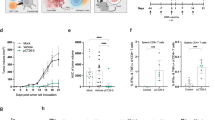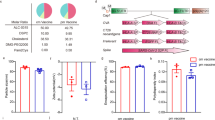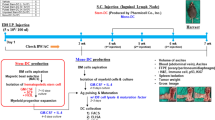Abstract
HER-2/neu is a candidate for developing breast cancer-targeted immunotherapeutics. Although DNA-based and HER-2/neu transgene-modified dendritic cell (DC)-based vaccines are potent at eliciting HER-2/neu-specific antitumor immunity, there has been no side-by-side study comparing them directly. The present study utilizes an in vivo murine tumor model expressing HER-2/neu antigen to compare the efficacy between adenovirus (AdVneu)-transfected dendritic cells (DCneu) and plasmid DNA (pcDNAneu) vaccine. Our data showed that DCneu upregulated the expression of immunologically important molecules and inflammatory cytokines and partially converted regulatory T (Tr)-cell suppression through interleukin-6 (IL-6) secretion. Vaccination of DCneu induced stronger HER-2/neu-specific humoral and cellular immune responses than DNA vaccination, which downregulated HER-2/neu expression and lysed HER-2/neu-positive tumor cells in vitro, respectively. In two HER-2/neu-expressing tumor models, DCneu completely protected mice from tumor cell challenge compared to partial or no protection observed in DNA-immunized mice. In addition, DCneu significantly delayed breast cancer development in transgenic mice in comparison to DNA vaccine (P<0.05). Taken together, we have demonstrated that HER-2/neu-gene-modified DC vaccine is more potent than DNA vaccine in both protective and preventive animal tumor models. Therefore, DCs genetically engineered to express tumor antigens such as HER-2/neu represent a new direction in DC vaccine of breast cancer.
This is a preview of subscription content, access via your institution
Access options
Subscribe to this journal
Receive 12 print issues and online access
$259.00 per year
only $21.58 per issue
Buy this article
- Purchase on Springer Link
- Instant access to full article PDF
Prices may be subject to local taxes which are calculated during checkout








Similar content being viewed by others
References
Coussens L, Yang-Feng TL, Liao YC, Chen E, Gray A, McGrath J et al. Tyrosine kinase receptor with extensive homology to EGF receptor shares chromosomal location with neu oncogene. Science 1985; 230: 1132–1139.
Nagata Y, Furugen R, Hiasa A, Ikeda H, Ohta N, Furukawa K et al. Peptides derived from a wild-type murine proto-oncogene c-erbB-2/HER2/neu can induce CTL and tumor suppression in syngeneic hosts. J Immunol 1997; 159: 1336–1343.
Slamon DJ, Godolphin W, Jones LA, Holt JA, Wong SG, Keith DE et al. Studies of the HER-2/neu proto-oncogene in human breast and ovarian cancer. Science 1989; 244: 707–712.
Andrulis IL, Bull SB, Blackstein ME, Sutherland D, Mak C, Sidlofsky S et al. neu/erbB-2 amplification identifies a poor-prognosis group of women with node-negative breast cancer. Toronto Breast Cancer Study Group. J Clin Oncol 1998; 16: 1340–1349.
Disis ML, Pupa SM, Gralow JR, Dittadi R, Menard S, Cheever MA . High-titer HER-2/neu protein-specific antibody can be detected in patients with early-stage breast cancer. J Clin Oncol 1997; 15: 3363–3367.
Disis ML, Calenoff E, McLaughlin G, Murphy AE, Chen W, Groner B et al. Existent T-cell and antibody immunity to HER-2/neu protein in patients with breast cancer. Cancer Res 1994; 54: 16–20.
Peoples GE, Goedegebuure PS, Smith R, Linehan DC, Yoshino I, Eberlein TJ . Breast and ovarian cancer-specific cytotoxic T lymphocytes recognize the same HER2/neu-derived peptide. Proc Natl Acad Sci USA 1995; 92: 432–436.
Gurunathan S, Klinman DM, Seder RA . DNA vaccines: immunology, application, and optimization. Annu Rev Immunol 2000; 18: 927–974.
Chen Y, Hu D, Eling DJ, Robbins J, Kipps TJ . DNA vaccines encoding full-length or truncated Neu induce protective immunity against Neu-expressing mammary tumors. Cancer Res 1998; 58: 1965–1971.
Amici A, Venanzi FM, Concetti A . Genetic immunization against neu/erbB2 transgenic breast cancer. Cancer Immunol Immunother 1998; 47: 183–190.
Foy TM, Bannink J, Sutherland RA, McNeill PD, Moulton GG, Smith J et al. Vaccination with Her-2/neu DNA or protein subunits protects against growth of a Her-2/neu-expressing murine tumor. Vaccine 2001; 19: 2598–2606.
Esserman LJ, Lopez T, Montes R, Bald LN, Fendly BM, Campbell MJ . Vaccination with the extracellular domain of p185neu prevents mammary tumor development in neu transgenic mice. Cancer Immunol Immunother 1999; 47: 337–342.
Rovero S, Amici A, Carlo ED, Bei R, Nanni P, Quaglino E et al. DNA vaccination against rat her-2/Neu p185 more effectively inhibits carcinogenesis than transplantable carcinomas in transgenic BALB/c mice. J Immunol 2000; 165: 5133–5142.
Pupa SM, Invernizzi AM, Forti S, Di Carlo E, Musiani P, Nanni P et al. Prevention of spontaneous neu-expressing mammary tumor development in mice transgenic for rat proto-neu by DNA vaccination. Gene Therapy 2001; 8: 75–79.
Rovero S, Boggio K, Carlo ED, Amici A, Quaglino E, Porcedda P et al. Insertion of the DNA for the 163–171 peptide of IL1beta enables a DNA vaccine encoding p185(neu) to inhibit mammary carcinogenesis in Her-2/neu transgenic BALB/c mice. Gene Therapy 2001; 8: 447–452.
Disis ML, Shiota FM, McNeel DG, Knutson KL . Soluble cytokines can act as effective adjuvants in plasmid DNA vaccines targeting self tumor antigens. Immunobiology 2003; 207: 179–186.
Chang SY, Lee KC, Ko SY, Ko HJ, Kang CY . Enhanced efficacy of DNA vaccination against Her-2/neu tumor antigen by genetic adjuvants. Int J Cancer 2004; 111: 86–95.
Wang X, Wang JP, Rao XM, Price JE, Zhou HS, Lachman LB . Prime-boost vaccination with plasmid and adenovirus gene vaccines control HER2/neu+ metastatic breast cancer in mice. Breast Cancer Res 2005; 7: R580–R588.
Quaglino E, Iezzi M, Mastini C, Amici A, Pericle F, Di Carlo E et al. Electroporated DNA vaccine clears away multifocal mammary carcinomas in her-2/neu transgenic mice. Cancer Res 2004; 64: 2858–2864.
Akbari O, Panjwani N, Garcia S, Tascon R, Lowrie D, Stockinger B . DNA vaccination: transfection and activation of dendritic cells as key events for immunity. J Exp Med 1999; 189: 169–178.
Schuler G, Koch F, Heufler C, Kampgen E, Topar G, Romani N . Murine epidermal Langerhans cells as a model to study tissue dendritic cells. Adv Exp Med Biol 1993; 329: 243–249.
Pardoll DM . Cancer vaccines. Nat Med 1998; 4: 525–531.
Ercolini AM, Machiels JP, Chen YC, Slansky JE, Giedlen M, Reilly RT et al. Identification and characterization of the immunodominant rat HER-2/neu MHC class I epitope presented by spontaneous mammary tumors from HER-2/neu-transgenic mice. J Immunol 2003; 170: 4273–4280.
Fallarino F, Grohmann U, Bianchi R, Vacca C, Fioretti MC, Puccetti P . Th1 and Th2 cell clones to a poorly immunogenic tumor antigen initiate CD8+ T cell-dependent tumor eradication in vivo. J Immunol 2000; 165: 5495–5501.
Chen Y, Emtage P, Zhu Q, Foley R, Muller W, Hitt M et al. Induction of ErbB-2/neu-specific protective and therapeutic antitumor immunity using genetically modified dendritic cells: enhanced efficacy by cotransduction of gene encoding IL-12. Gene Therapy 2001; 8: 316–323.
Chen Z, Huang H, Chang T, Carlsen S, Saxena A, Marr R et al. Enhanced HER-2/neu-specific antitumor immunity by cotransduction of mouse dendritic cells with two genes encoding HER-2/neu and alpha tumor necrosis factor. Cancer Gene Ther 2002; 9: 778–786.
zum Buschenfelde CM, Metzger J, Hermann C, Nicklisch N, Peschel C, Bernhard H . The generation of both T killer and Th cell clones specific for the tumor-associated antigen HER2 using retrovirally transduced dendritic cells. J Immunol 2001; 167: 1712–1719.
Dees EC, McKinnon KP, Kuhns JJ, Chwastiak KA, Sparks S, Myers M et al. Dendritic cells can be rapidly expanded ex vivo and safely administered in patients with metastatic breast cancer. Cancer Immunol Immunother 2004; 53: 777–785.
Sakai Y, Morrison BJ, Burke JD, Park JM, Terabe M, Janik JE et al. Vaccination by genetically modified dendritic cells expressing a truncated neu oncogene prevents development of breast cancer in transgenic mice. Cancer Res 2004; 64: 8022–8028.
Xiang J, Moyana T . Regression of engineered tumor cells secreting cytokines is related to a shift in host cytokine profile from type 2 to type 1. J Interferon Cytokine Res 2000; 20: 349–354.
Pasare C, Medzhitov R . Toll pathway-dependent blockade of CD4+CD25+ T cell-mediated suppression by dendritic cells. Science 2003; 299: 1033–1036.
Yip YL, Smith G, Koch J, Dubel S, Ward RL . Identification of epitope regions recognized by tumor inhibitory and stimulatory anti-ErbB-2 monoclonal antibodies: implications for vaccine design. J Immunol 2001; 166: 5271–5278.
Weiner LM . Monoclonal antibody therapy of cancer. Semin Oncol 1999; 26: 43–51.
Kobayashi H, Wood M, Song Y, Appella E, Celis E . Defining promiscuous MHC class II helper T-cell epitopes for the HER2/neu tumor antigen. Cancer Res 2000; 60: 5228–5236.
Wei WZ, Shi WP, Galy A, Lichlyter D, Hernandez S, Groner B et al. Protection against mammary tumor growth by vaccination with full-length, modified human ErbB-2 DNA. Int J Cancer 1999; 81: 748–754.
Piechocki MP, Pilon SA, Wei WZ . Complementary antitumor immunity induced by plasmid DNA encoding secreted and cytoplasmic human ErbB-2. J Immunol 2001; 167: 3367–3374.
Pilon SA, Piechocki MP, Wei WZ . Vaccination with cytoplasmic ErbB-2 DNA protects mice from mammary tumor growth without anti-ErbB-2 antibody. J Immunol 2001; 167: 3201–3206.
Dietz AB, Bulur PA, Brown CA, Pankratz VS, Vuk-Pavlovic S . Maturation of dendritic cells infected by recombinant adenovirus can be delayed without impact on transgene expression. Gene Therapy 2001; 8: 419–423.
Miller G, Lahrs S, Pillarisetty VG, Shah AB, DeMatteo RP . Adenovirus infection enhances dendritic cell immunostimulatory properties and induces natural killer and T-cell-mediated tumor protection. Cancer Res 2002; 62: 5260–5266.
Robinet E, Branellec D, Termijtelen AM, Blay JY, Gay F, Chouaib S . Evidence for tumor necrosis factor-alpha involvement in the optimal induction of class I allospecific cytotoxic T cells. J Immunol 1990; 144: 4555–4561.
Brunner C, Seiderer J, Schlamp A, Bidlingmaier M, Eigler A, Haimerl W et al. Enhanced dendritic cell maturation by TNF-alpha or cytidine-phosphate-guanosine DNA drives T cell activation in vitro and therapeutic anti-tumor immune responses in vivo. J Immunol 2000; 165: 6278–6286.
Brossart P, Zobywalski A, Grunebach F, Behnke L, Stuhler G, Reichardt VL et al. Tumor necrosis factor alpha and CD40 ligand antagonize the inhibitory effects of interleukin 10 on T-cell stimulatory capacity of dendritic cells. Cancer Res 2000; 60: 4485–4492.
Sozzani S, Locati M, Allavena P, Van Damme J, Mantovani A . Chemokines: a superfamily of chemotactic cytokines. Int J Clin Lab Res 1996; 26: 69–82.
Cuello M, Ettenberg SA, Clark AS, Keane MM, Posner RH, Nau MM et al. Down-regulation of the erbB-2 receptor by trastuzumab (herceptin) enhances tumor necrosis factor-related apoptosis-inducing ligand-mediated apoptosis in breast and ovarian cancer cell lines that overexpress erbB-2. Cancer Res 2001; 61: 4892–4900.
Murata S, Ladle BH, Kim PS, Lutz ER, Wolpoe ME, Ivie SE et al. OX40 costimulation synergizes with GM-CSF whole-cell vaccination to overcome established CD8+ T cell tolerance to an endogenous tumor antigen. J Immunol 2006; 176: 974–983.
Guy CT, Webster MA, Schaller M, Parsons TJ, Cardiff RD, Muller WJ . Expression of the neu protooncogene in the mammary epithelium of transgenic mice induces metastatic disease. Proc Natl Acad Sci USA 1992; 89: 10578–10582.
Cifaldi L, Quaglino E, Di Carlo E, Musiani P, Spadaro M, Lollini PL et al. A light, nontoxic interleukin 12 protocol inhibits HER-2/neu mammary carcinogenesis in BALB/c transgenic mice with established hyperplasia. Cancer Res 2001; 61: 2809–2812.
Reilly RT, Gottlieb MB, Ercolini AM, Machiels JP, Kane CE, Okoye FI et al. HER-2/neu is a tumor rejection target in tolerized HER-2/neu transgenic mice. Cancer Res 2000; 60: 3569–3576.
Takeuchi N, Hiraoka S, Zhou XY, Nagafuku M, Ono S, Tsujimura T et al. Anti-HER-2/neu immune responses are induced before the development of clinical tumors but declined following tumorigenesis in HER-2/neu transgenic mice. Cancer Res 2004; 64: 7588–7595.
Condon C, Watkins SC, Celluzzi CM, Thompson K, Falo Jr LD . DNA-based immunization by in vivo transfection of dendritic cells. Nat Med 1996; 2: 1122–1128.
Troy AJ, Summers KL, Davidson PJ, Atkinson CH, Hart DN . Minimal recruitment and activation of dendritic cells within renal cell carcinoma. Clin Cancer Res 1998; 4: 585–593.
Chaux P, Favre N, Martin M, Martin F . Tumor-infiltrating dendritic cells are defective in their antigen-presenting function and inducible B7 expression in rats. Int J Cancer 1997; 72: 619–624.
Bargmann CI, Hung MC, Weinberg RA . The neu oncogene encodes an epidermal growth factor receptor-related protein. Nature 1986; 319: 226–230.
Wright P, Braun R, Babiuk L, Littel-van den Hurk SD, Moyana T, Zheng C et al. Adenovirus-mediated TNF-alpha gene transfer induces significant tumor regression in mice. Cancer Biother Radiopharm 1999; 14: 49–57.
Luo D, Saltzman WM . Synthetic DNA delivery systems. Nat Biotechnol 2000; 18: 33–37.
Van Tendeloo VF, Ponsaerts P, Lardon F, Nijs G, Lenjou M, Van Broeckhoven C et al. Highly efficient gene delivery by mRNA electroporation in human hematopoietic cells: superiority to lipofection and passive pulsing of mRNA and to electroporation of plasmid cDNA for tumor antigen loading of dendritic cells. Blood 2001; 98: 49–56.
Lundqvist A, Noffz G, Pavlenko M, Saeboe-Larssen S, Fong T, Maitland N et al. Nonviral and viral gene transfer into different subsets of human dendritic cells yield comparable efficiency of transfection. J Immunother 2002; 25: 445–454.
Wu Q, Xia D, Carlsen S, Xiang J . Adenovirus-mediated transgene-engineered dendritic cell vaccine of cancer. Curr Gene Ther 2005; 5: 237–247.
Frolkis M, Fischer MB, Wang Z, Lebkowski JS, Chiu CP, Majumdar AS . Dendritic cells reconstituted with human telomerase gene induce potent cytotoxic T-cell response against different types of tumors. Cancer Gene Ther 2003; 10: 239–249.
Liu Y, Huang H, Chen Z, Zong L, Xiang J . Dendritic cells engineered to express the Flt3 ligand stimulate type I immune response, and induce enhanced cytoxic T and natural killer cell cytotoxicities and antitumor immunity. J Gene Med 2003; 5: 668–680.
Yang J, Moyana T, Xiang J . A genetically engineered single-chain FV/TNF molecule possesses the anti-tumor immunoreactivity of FV as well as the cytotoxic activity of tumor necrosis factor. Mol Immunol 1995; 32: 873–881.
Xiang J, Qi Y, Cook D, Moyana T . Targeting gamma interferon to tumor cells by a genetically engineered fusion protein secreted from myeloma cells. Hum Antibodies Hybridomas 1996; 7: 2–10.
Xiang J, Huang H, Liu Y . A new dynamic model of CD8+ T effector cell responses via CD4+ T helper-antigen-presenting cells. J Immunol 2005; 174: 7497–7505.
Okada N, Tsujino M, Hagiwara Y, Tada A, Tamura Y, Mori K et al. Administration route-dependent vaccine efficiency of murine dendritic cells pulsed with antigens. Br J Cancer 2001; 84: 1564–1570.
Fong L, Brockstedt D, Benike C, Wu L, Engleman EG . Dendritic cells injected via different routes induce immunity in cancer patients. J Immunol 2001; 166: 4254–4259.
Davis HL, Michel ML, Mancini M, Schleef M, Whalen RG . Direct gene transfer in skeletal muscle: plasmid DNA-based immunization against the hepatitis B virus surface antigen. Vaccine 1994; 12: 1503–1509.
Gramzinski RA, Millan CL, Obaldia N, Hoffman SL, Davis HL . Immune response to a hepatitis B DNA vaccine in Aotus monkeys: a comparison of vaccine formulation, route, and method of administration. Mol Med 1998; 4: 109–118.
Acknowledgements
This study was supported by research grants from Canadian Institute of Health Research and Saskatchewan Cancer Agency. The excellent flow cytometric analysis provided by Mark Boyd is greatly appreciated.
Author information
Authors and Affiliations
Corresponding author
Rights and permissions
About this article
Cite this article
Chan, T., Sami, A., El-Gayed, A. et al. HER-2/neu-gene engineered dendritic cell vaccine stimulates stronger HER-2/neu-specific immune responses compared to DNA vaccination. Gene Ther 13, 1391–1402 (2006). https://doi.org/10.1038/sj.gt.3302797
Received:
Revised:
Accepted:
Published:
Issue Date:
DOI: https://doi.org/10.1038/sj.gt.3302797
Keywords
This article is cited by
-
Potent CD4+ T-cell epitope P30 enhances HER2/neu-engineered dendritic cell-induced immunity against Tg1-1 breast cancer in transgenic FVBneuN mice by enhanced CD4+ T-cell-stimulated CTL responses
Cancer Gene Therapy (2013)
-
Exosomal pMHC-I complex targets T cell-based vaccine to directly stimulate CTL responses leading to antitumor immunity in transgenic FVBneuN and HLA-A2/HER2 mice and eradicating trastuzumab-resistant tumor in athymic nude mice
Breast Cancer Research and Treatment (2013)
-
Adjuvant effect of HER-2/neu-specific adenoviral vector stimulating CD8+ T and natural killer cell responses on anti-HER-2/neu antibody therapy for well-established breast tumors in HER-2/neu transgenic mice
Cancer Gene Therapy (2011)
-
Persistent expression of biologically active anti-HER2 antibody by AAVrh.10-mediated gene transfer
Cancer Gene Therapy (2010)
-
Concurrent vaccination with two distinct vaccine platforms targeting the same antigen generates phenotypically and functionally distinct T-cell populations
Cancer Immunology, Immunotherapy (2010)



